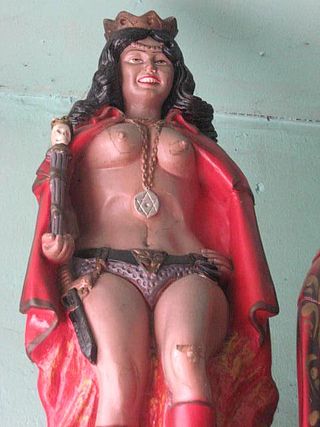Top Qs
Timeline
Chat
Perspective
Pomba Gira
Figure in Brazilian mythology From Wikipedia, the free encyclopedia
Remove ads
Pombajira (from Kimbundu: pambu ia njila, lit. 'crossroads'[1]) is the name of an Afro-Brazilian spirit evoked by practitioners of Umbanda and Quimbanda in Brazil.[2][3] She is the consort of Exu, who is the messenger of the Orixas in Candomblé. Known by many names, or avatars, Pombajira is often associated with the number seven, crossroads, graveyards, spirit possession, and witchcraft.
Remove ads
Tradition
While Exu represents male sexuality, fertility and strength, Pombajira personifies female sexuality, beauty and desire.[4] She is depicted as a beautiful woman who is insatiable. Pombajira is venerated with great respect and care because of her reputation for possessing great wrath. She is often invoked by those who seek aid in matters of the heart and love.[5]
Pombajira is noted for her connection with both transgender women and effeminate male worshippers and is reputed to possess both.[6] [7] Some representations of Pombajira display the characteristics of being promiscuous, talkative and vulgar. However she has many avatars, and will be more or less inclined towards that behavior depending on how she manifests herself.
Remove ads
Avatars
Summarize
Perspective
Pombajiras can manifest with many names, known as "falanges" (phalanges). Some most known pombajira's names are:
- Dama da Noite (Lady of the Night)
- Maria Mulambo da Lixeira (Filthy Mary of the Trash Can)
- Maria Mulambo das Sete Catacumbas (Filthy Mary of the Seven Tombs)
- Maria Mulambo das Cavaleiras de Vassoura da Meia-Noixe (Filthy Mary of the Midnight Broom-Riders)
- Maria Padilha (Mary Padilla)
- Maria Quitéria (Warrior Mary), unrelated to Maria Quitéria
- Pombajira Cigana (Gypsy Pombajira)
- Pombajira do Ouro (Pombagira of the Gold)
- Pombajira das Almas (Pombajira of Souls)
- Pombajira das Cobras (Pombajira of Snakes)
- Pombajira das Sete Encruzilhadas (Pombajira of the Seven Crossroads)
- Pombajira dos Sete Cruzeiros da Calunga (Pombajira of the Seven Crosses of Kalunga)
- Pombajira da Praia (Pombajira of the Beach)
- Pombajira Mirongueira (Enchantress Pombajira)
- Pombajira Mocinha ou Menina (Young Girl Pombajira)
- Pombajira Rainha (Queen Pombajira)
- Pombajira Sete Calungas (Pombajira Seven Kalungas)
- Rainha do Cemitério (Queen of the Graveyard)
- Rainha Sete Encruzilhadas (Queen of the Seven Crossroads)
- Rosa Caveira (Skull Rose)
- Pombajira Rainha do Inferno (Pombajira Queen of Hell)
- Pombajira Sete Saias (Pombajira Seven skirts)
- Pombajira Rosa Caveira (Pombajira Skull Rose)
- Pombajira do Cabaré (Night Club Pombagira)
- Pombajira Sete Saias (Pombajira Seven Skirts)
- Pombajira Tatá Mulambo (Pombajira Older Filthy)
- Pombajira das Rosas (Pombajira of the roses)
- Pombajira das Sete Rosas (Pombajira of the Seven Roses)
- Pombagira Rosa Vermelha (Pombagira Red Rose)
Remove ads
References
Bibliography
External links
Wikiwand - on
Seamless Wikipedia browsing. On steroids.
Remove ads

